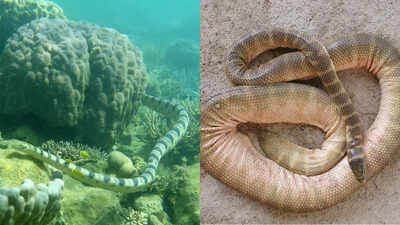Trending
7 venomous sea snakes in the world that are more deadly than king cobra
The sea harbors some of the world's deadliest venomous sea snakes, including the black-banded sea krait, olive-headed sea snake, and others. Despite their potent venom, human encounters are rare, and these snakes play significant roles in their marine ecosystems. Notable species include the highly aggressive Stokes's sea snake and the elusive Belcher's sea snake.
The sea conceals some of the planet's most deadly inhabitants, and among them are the planet's most venomous sea snakes. These deadly snakes, unlike their land-dwelling relatives, slither through the ocean with ease, carrying venom so deadly that it can kill a human in a matter of hours. The silent killers reside in tropical seas from the Indian Ocean to the Pacific, going undetected—until too late. Others are so poisonous that they can kill thousands with only a few milligrams of venom. But even though they have a deadly reputation, sea snake bites are infrequent. Sea snakes are valuable members of the ocean ecosystem, but their venom is still one of nature's strongest weapons.
7 deadly sea snakes found in the world’s oceans
Black-banded sea krait
This snake is readily recognized by its black and bluish-gray bands that alternate and a prominent yellow upper lip. It occurs in the western Pacific Ocean, specifically off Japan, China, Taiwan, the Philippines, and Indonesia. Unlike strictly aquatic sea snakes, the black-banded sea krait is semi-terrestrial and regularly comes onto land to rest and breed. It mostly feeds on eels and small fish in coral reef habitats. While being extremely venomous, it is a peaceful animal and does not usually attack human beings.

Olive-headed sea snake
Also known as the greater sea snake, this species inhabits the warm seas of the Indo-Pacific. The olive-headed sea snake grows to 1.5 meters in length and has an olive head and pale body with dark bands. Preying on fish and eels, it injects venom into its victims to incapacitate them. Notwithstanding its toxicity, the olive-headed sea snake is not aggressive and human encounters are usually harmless.

Yellow-lipped sea krait
They are also referred to as banded sea kraits or columbine sea kraits and are natives of the Indo-Pacific Ocean. The bodies of these beautifully patterned snakes vary in color from dark blue to bluish-gray and have wide black bands on them. The yellow markings close to their mouths, which could be an indicator of their deadly venom, is another identifying feature. In contrast to most totally aquatic sea snakes, they possess a paddle tail with which to swim efficiently but are often on the beach resting or reproducing. Extremely venomous, they incapacitate their eel and tiny fish prey through their neurotoxic venom. Though their bite is deadly, they are rarely aggressive towards man.

Stoke's sea snake
Stokes's sea snake is the most aggressive of all sea snakes. It lives in the warm coastal waters of the Indian and Pacific Oceans and is one of the heavier sea snake species, reaching lengths of 5 feet (1.5 meters). This species has some of the longest fangs of any sea snake, enabling it to effectively inject venom into its prey, which is mainly fish. Although its venom is extremely powerful, no human deaths have been reported for this species. It was originally described in 1846 by British explorer and naval officer John Lort Stokes, for whom it is named. Its paddle-like tail makes it a skilled swimmer in aquatic habitats.

Beaked sea snake
Widely regarded as being among the most venomous sea snakes, the beaked sea snake has extremely powerful venom. It is also one of the more aggressive species and thus is especially dangerous. The Marine Education Society of Australia states that this common species is accountable for about 90% of all reported sea snake bite deaths. Owing to the curvature of its nostrils, it is also called the hook-nosed sea snake. Beaked sea snakes mostly live in coastal waters of India and nearby islands, where they feed on fish employing their potent venom to paralyze prey. Although they are dangerous, they usually keep away from humans unless threatened.

Dubois Reef sea snake
Dubois' sea snake, also referred to as the Dubois Reef sea snake, is distributed in the seaways surrounding northern Australia, New Caledonia, and Papua New Guinea. It possesses a tan-colored trunk with weakly marked net patterns that enable the snake to easily camouflage itself with its coral reef environment. With comparatively short fangs, however, this particular species injects a very effective venom, supported by a confirmed venom yield per bite of 0.43 mg. Research says that its venom is among the most lethal of any snake, only slightly behind the inland taipan and eastern brown snake. Dubois' sea snakes feed mainly on fish and eels, killing them with their neurotoxic venom. Although they are highly venomous, they are not normally aggressive to human beings.

Belcher’s sea snake
Also referred to as the faint-banded sea snake, Belcher's sea snake is commonly listed as one of the world's most venomous snakes. Its venom is a highly potent combination of neurotoxins and myotoxins that can result in extreme paralysis and muscle necrosis. Yet, this snake is not venomous, and reported bites on humans are extremely uncommon. Described in honor of British explorer Sir Edward Belcher, who found it during the mid-1800s, this shy snake is seen off the coast of New Guinea, Indonesia, the Philippines, the Solomon Islands, and Australia. Even in its known area, they are not easily seen, which means encounters between humans and this extremely venomous species are all the less probable.

Also Read: Haldi ceremony inside Agra Metro? Influencer’s viral video sparks controversy
End of Article
FOLLOW US ON SOCIAL MEDIA
Visual Stories
Tired of too many ads?






